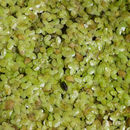Comments
provided by eFloras
I know of no specimens of Lemna minuta from Mississippi, but the species is to be expected there.
- license
- cc-by-nc-sa-3.0
- copyright
- Missouri Botanical Garden, 4344 Shaw Boulevard, St. Louis, MO, 63110 USA
Description
provided by eFloras
Roots to 1.5 cm, tip rounded to pointed; sheath not winged. Stipes white, small, often decaying. Fronds floating, 1 or 2--few, coherent in groups, obovate, flat to thickish (but not gibbous), 0.8--4 mm, 1--2 times as long as wide, margins entire; veins 1, sometimes indistinct, very rarely longer than extension of air spaces, not longer than 2/3 of distance between node and apex; with or without small papillae along midline; anthocyanin absent; largest air spaces much shorter than 0.3 mm; turions absent. Flowers: ovaries 1-ovulate, utricular scale open on 1 side. Fruits 0.6--1 mm, not winged. Seeds with 12--15 distinct ribs. 2n = 36 (U), 40 (U), 42 (G).
- license
- cc-by-nc-sa-3.0
- copyright
- Missouri Botanical Garden, 4344 Shaw Boulevard, St. Louis, MO, 63110 USA
Distribution
provided by eFloras
Ala., Ariz., Ark., Calif., Colo., Fla., Ga., Ill., Ind., Kans., Ky., La., Mich., Mo., Nebr., Nev., N.Mex., Ohio, Okla., Oreg., Tenn., Tex., Utah, Wash., W.Va., Wyo.; Mexico; West Indies; Central America; South America; introduced, Eurasia (introduced).
- license
- cc-by-nc-sa-3.0
- copyright
- Missouri Botanical Garden, 4344 Shaw Boulevard, St. Louis, MO, 63110 USA
Flowering/Fruiting
provided by eFloras
Flowering (very rare) late spring--early fall.
- license
- cc-by-nc-sa-3.0
- copyright
- Missouri Botanical Garden, 4344 Shaw Boulevard, St. Louis, MO, 63110 USA
Habitat
provided by eFloras
Mesotrophic to eutrophic, quiet waters in temperate to subtropical regions with relatively mild winters; 0--2600m.
- license
- cc-by-nc-sa-3.0
- copyright
- Missouri Botanical Garden, 4344 Shaw Boulevard, St. Louis, MO, 63110 USA
Synonym
provided by eFloras
Lemna minima Philippi; L. minuscula Herter
- license
- cc-by-nc-sa-3.0
- copyright
- Missouri Botanical Garden, 4344 Shaw Boulevard, St. Louis, MO, 63110 USA
Lemna minuta
provided by wikipedia EN
Lemna minuta is a species of duckweed known by the common name least duckweed.[1][2] It is the smallest Lemna species.[3] It is native to parts of the Americas, and naturalized in others; the exact native range is not known. It is found on other continents as a non-native introduction as well. The plant's distribution is ever-expanding; it has been spreading in Europe and it was described from Poland for the first time in 2007.[4] In many areas it is a noxious weed, such as in Belgium.[5]
This tiny plant varies in shape depending on growth conditions. In the shade it is a single green translucent oval body no more than 2.5 millimeters long, and in full sunlight it generally grows in pairs. There is a central vein usually visible under magnification and microscopy. The plant produces an ephemeral membrane-bound flower.
This duckweed grows in slow-moving, calm, and stagnant freshwater habitats. It affects the ecology of its habitat by forming mats on the water surface, reducing sunlight penetration and oxygen exchange.[5]
References

- license
- cc-by-sa-3.0
- copyright
- Wikipedia authors and editors
Lemna minuta: Brief Summary
provided by wikipedia EN
Lemna minuta is a species of duckweed known by the common name least duckweed. It is the smallest Lemna species. It is native to parts of the Americas, and naturalized in others; the exact native range is not known. It is found on other continents as a non-native introduction as well. The plant's distribution is ever-expanding; it has been spreading in Europe and it was described from Poland for the first time in 2007. In many areas it is a noxious weed, such as in Belgium.
This tiny plant varies in shape depending on growth conditions. In the shade it is a single green translucent oval body no more than 2.5 millimeters long, and in full sunlight it generally grows in pairs. There is a central vein usually visible under magnification and microscopy. The plant produces an ephemeral membrane-bound flower.
This duckweed grows in slow-moving, calm, and stagnant freshwater habitats. It affects the ecology of its habitat by forming mats on the water surface, reducing sunlight penetration and oxygen exchange.
- license
- cc-by-sa-3.0
- copyright
- Wikipedia authors and editors

